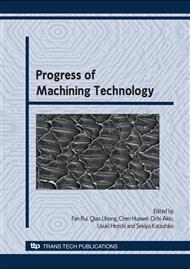p.456
p.460
p.465
p.469
p.473
p.478
p.482
p.486
p.490
Study on the Chip-Breaking Behavior under the Concept of Equivalent Parameters for Complicated Groove Insert in 45 Cutting Steel
Abstract:
Chip control is a major problem to be solved in automated machining system. It involves a total system to produce chips that can be evacuated easily and reliably from the working zone and can be disposed of efficiently. In order to realize those, prediction of chip-breaking in machining is one of effective methods. In this paper, to predict the chip breakage systematically, the equivalent parameters concept is used. Through presenting a study of the effect of complicated groove insert equivalent parameters on chip formation and breaking, a predictive model of chip-breaking is constructed. Finally, chip-breaking experiments are made and the tested results show that differential chip-breaking point’s ratio is fewer than five percent, so it proves that the chip-breaking predictive model is reasonable.
Info:
Periodical:
Pages:
473-477
Citation:
Online since:
February 2009
Authors:
Price:
Сopyright:
© 2009 Trans Tech Publications Ltd. All Rights Reserved
Share:
Citation:


